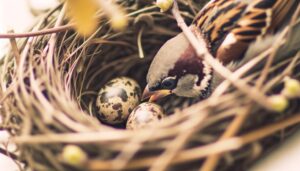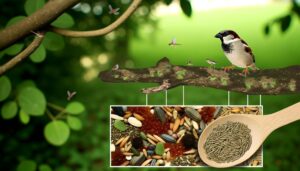How Many Eggs Does a Sparrow Hawk Lay?
Sparrow hawks, scientifically known as small birds of prey, exhibit fascinating reproductive behaviors. During each breeding season, a female sparrow hawk typically lays between 3 to 6 eggs.
The specific number can be influenced by various factors, such as environmental conditions and the overall health of the breeding pair. Best food availability and minimal predation pressures often result in larger clutches.
Incubation, primarily conducted by the female, lasts around 29 to 35 days, during which temperature regulation is essential for embryonic development. The interplay of these factors offers deeper insights into the reproductive ecology of sparrow hawks.
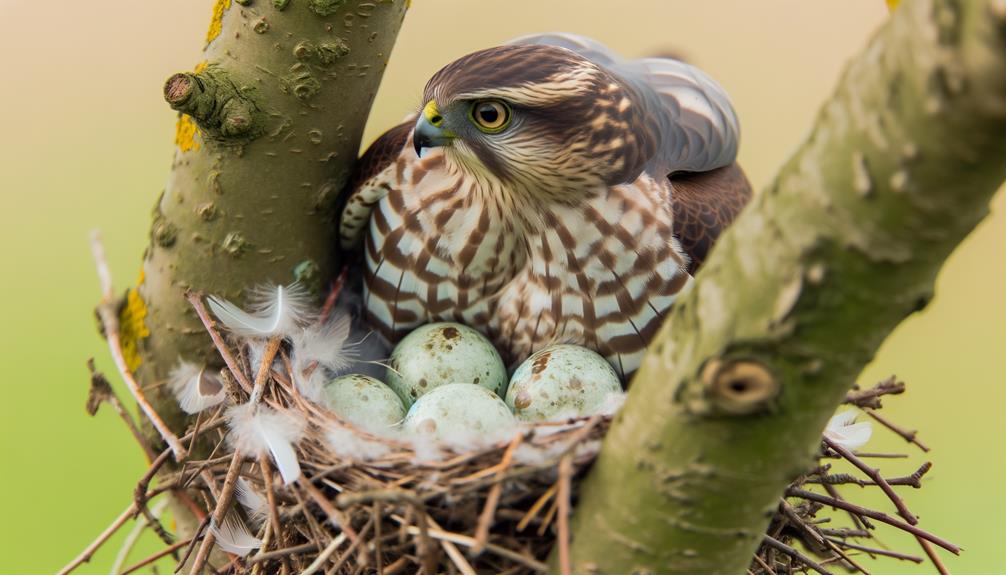
Key Takeaways
- Sparrow hawks typically lay between 3 to 6 eggs per breeding season.
- Clutch size is influenced by environmental conditions and the health of the breeding pair.
- Abundant prey availability can lead to larger clutches.
- Scarce food sources and harsh weather can result in smaller clutches.
- Younger and healthier females usually produce more eggs.
Sparrow Hawk Overview

The sparrow hawk (Accipiter nisus), a small bird of prey belonging to the family Accipitridae, is known for its agility and swift hunting skills that enable it to capture small birds in flight.
Characterized by sexual dimorphism, females are notably larger than males. The plumage varies with age and sex; adult males exhibit bluish-grey upperparts and orange-barred underparts, while females and juveniles display brownish upperparts and less vivid barring.
Adapted to woodland environments, sparrow hawks utilize dense foliage for cover during hunting. Their hunting strategy mainly involves surprise attacks from concealed perches.
Sparrow hawks play an important role in maintaining the ecological balance by regulating the populations of small birds, thereby contributing to biodiversity in their habitats.
Breeding Season Timing
Typically, sparrow hawks start their breeding season in late spring, with timing varying slightly based on geographic location and environmental conditions. In temperate regions, this period often spans from April to early June.
The onset of breeding is closely linked to the availability of prey, which guarantees sufficient food supply for the growing chicks. Environmental factors such as temperature and daylight hours play critical roles in triggering reproductive behaviors.
Males begin courtship displays and territory establishment, while females prepare for egg-laying. Breeding synchronization within populations is crucial for optimizing reproductive success. This strategic timing maximizes the likelihood of offspring survival, as it coincides with peak periods of prey abundance, ensuring that both adults and their young can thrive.
Nesting Habits
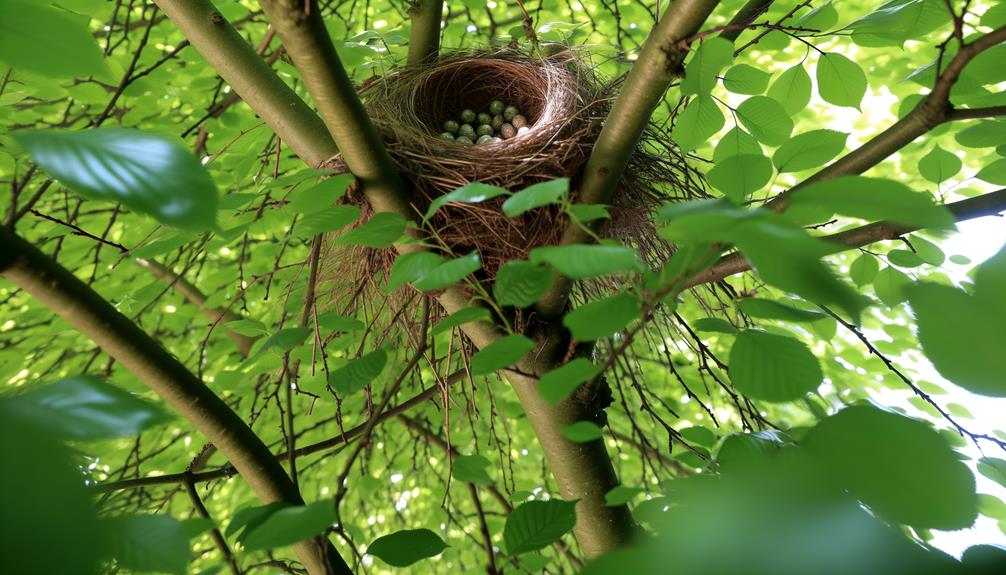
Sparrow hawks demonstrate specific preferences for their nesting locations, typically selecting secluded areas in dense foliage to enhance the protection of their eggs and young.
The incubation period for sparrow hawk eggs generally spans 28 to 32 days, during which the female primarily undertakes incubation duties.
Understanding these nesting habits is essential for comprehending the reproductive strategies and survival mechanisms of this raptor species.
Nest Location Preferences
Preferring wooded areas and open fields, sparrow hawks often select nesting sites that provide both ample cover and a clear vantage point for hunting. These raptors typically nest in deciduous or mixed woodlands, often opting for areas near forest edges.
The chosen nest location is generally high in trees, utilizing old nests of other birds such as crows or magpies. This strategic selection allows sparrow hawks to maximize their hunting efficiency, as they can easily spot and swoop down on prey in the open fields or edge habitats. Additionally, the dense foliage offers protection from potential predators and harsh weather conditions, ensuring a safer environment for raising their young.
This combination of factors influences their nesting site preferences significantly.
Egg Incubation Period
Following the careful selection of a nesting site, the egg incubation period for sparrow hawks is a vital phase in their reproductive cycle, typically lasting around 29 to 35 days. During this period, the female mainly undertakes the incubation duties, meticulously maintaining the eggs at an ideal temperature. This temperature regulation is essential for embryonic development.
The male contributes by providing food and protection, ensuring minimal disturbance to the nest. Both sexes exhibit heightened vigilance against potential predators. The eggs, usually numbering between three and five, are incubated continuously, requiring synchronized parental cooperation.
The duration and success of the incubation period are influenced by environmental factors, such as temperature and food availability, underscoring the species' adaptability and resilience.
Typical Clutch Size
In examining the typical clutch size of the sparrow hawk, research indicates that the species generally lays between 3 to 6 eggs per breeding season.
The frequency of egg laying can vary based on environmental conditions and the health of the breeding pair.
Several factors, such as food availability and predation pressures, notably influence the number of eggs produced.
Average Clutch Size
The average clutch size of a sparrow hawk typically ranges from three to six eggs. This range may vary slightly depending on environmental factors, food availability, and geographical location.
Sparrow hawks, known scientifically as Accipiter nisus, exhibit high adaptability in their reproductive strategies. The number of eggs laid can influence the survival rate of offspring, as larger clutches may indicate favorable conditions. Each egg is usually incubated for approximately 33 days, with both parents participating in the process.
Variability in clutch size is also linked to the age and health of the female, as younger or more experienced females may produce larger clutches. Understanding these factors provides insights into the reproductive ecology of sparrow hawks.
Egg Laying Frequency
Considering the variability in clutch size, sparrow hawks typically lay one clutch of eggs per breeding season, with the frequency of egg-laying events within that period being influenced by environmental and physiological factors.
The average clutch size ranges from three to six eggs, though this number can vary slightly based on regional and individual differences.
The egg-laying process begins in early spring, often aligning with ideal conditions for chick survival. The laying interval between successive eggs is usually 1-2 days, guaranteeing a staggered hatching period.
Once the clutch is complete, the female primarily undertakes incubation over a span of approximately 30 days. This strategic timing maximizes reproductive success and secures the offspring have the best chances for survival.
Factors Influencing Clutch
Several ecological and biological factors notably influence the typical clutch size of sparrow hawks. These factors include food availability, habitat quality, and parental health. Abundant food sources enable females to produce larger clutches. Nutritional adequacy supports egg production and chick rearing.
Habitat quality, including nesting site security and environmental stability, also plays an important role. Ideal habitats reduce predation risks and enhance reproductive success. Moreover, the health and age of the breeding pair are vital. Healthier, more experienced parents tend to lay more eggs due to their enhanced capability to provide care and protection.
Seasonal variations and climatic conditions additionally impact clutch size. Favorable weather patterns can lead to increased reproductive output, while adverse conditions may require smaller clutches for survival.
Factors Influencing Clutch Size

Among the myriad factors influencing the clutch size of a sparrow hawk, environmental conditions such as food availability and weather patterns play a pivotal role. Abundant prey leads to larger clutches, as ample nutrition supports the energetic demands of egg production. Conversely, scarce food sources can result in smaller clutches, ensuring parental investment aligns with resource availability.
In addition, weather conditions critically influence clutch size; harsh weather can reduce prey accessibility, restricting the number of eggs laid. The age and health of the female sparrow hawk play a crucial role in clutch size, with younger, healthier females generally producing more eggs. Finally, predation pressure and habitat quality also contribute, as safer, resource-rich environments enable larger clutches.
Egg Incubation Period
The egg incubation period for a sparrow hawk typically ranges from 28 to 35 days. During this time, the female primarily undertakes the incubation duties while the male provides food. This period is crucial for embryonic development, as the eggs require consistent temperatures that the female maintains through body heat.
The female sparrow hawk carefully rotates the eggs to ensure even warmth distribution and prevent developmental abnormalities. She spends the majority of her time on the nest, leaving only briefly for essential activities. Environmental conditions, such as temperature and humidity, also play a significant role in the incubation success.
The male's role in supplying food is vital, allowing the female to dedicate her time to maintaining optimal conditions for the eggs.
Hatchling Care
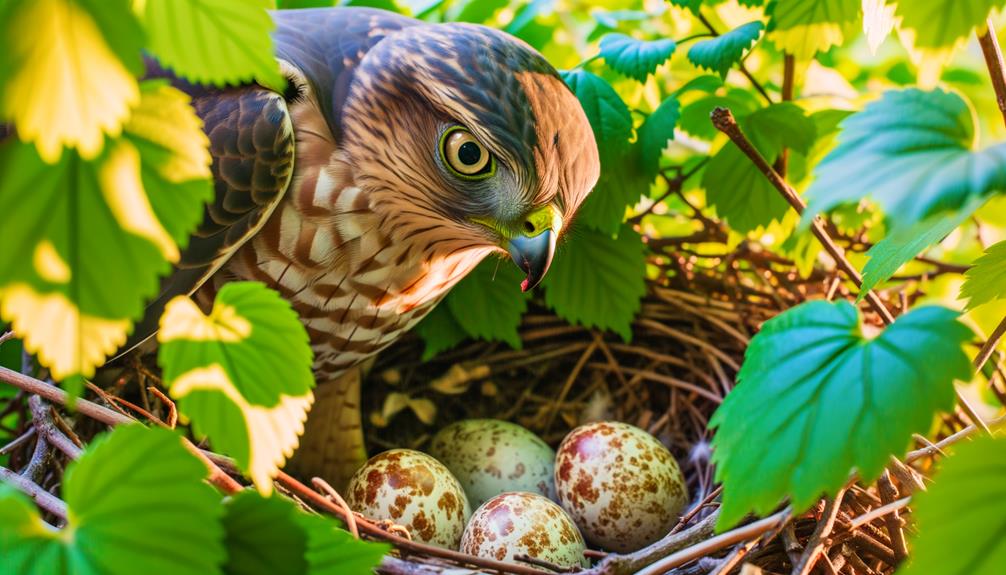
Upon the successful completion of the incubation period, the female sparrow hawk's attention shifts to the meticulous care and feeding of the newly hatched chicks. These hatchlings, altricial in nature, emerge blind and helpless, necessitating constant parental supervision.
The female primarily handles brooding, maintaining the appropriate temperature for the chicks, while the male assumes the role of primary food provider. Prey, often small birds and mammals, is delivered to the nest, where the female tears it into manageable pieces for the chicks.
Frequent feedings are pivotal, as rapid growth demands high caloric intake. This period of intensive care typically lasts for about 4 to 6 weeks, during which the chicks progressively gain strength, coordination, and feather development.
Survival Rates
Survival rates of sparrow hawk chicks are influenced by a variety of factors including predation, food availability, and environmental conditions. Predation from larger birds of prey and mammals poses a significant threat, particularly during the early stages of life.
Food scarcity, often due to fluctuations in small mammal and bird populations, can lead to starvation or poor health, reducing survival chances. Additionally, harsh weather conditions, such as prolonged rain or extreme cold, can impact chick development and mortality.
Parental care also plays an important role; attentive and experienced parents are more likely to successfully rear chicks to fledgling stage. The interplay of these elements significantly determines the overall survival rates of sparrow hawk offspring.
Role in the Ecosystem

Essential for maintaining ecological equilibrium, sparrow hawks play a crucial role as apex predators, regulating the populations of small mammals and birds within their habitats. By preying on species such as rodents, small birds, and insects, these raptors help control potential overpopulation and the subsequent strain on local resources.
This predatory behavior indirectly promotes plant health by reducing herbivory pressure. Additionally, sparrow hawks contribute to the genetic diversity of prey populations by culling the weak and diseased individuals, thereby fostering evolutionary adaptation.
Their presence also supports a complex web of interdependent species, ensuring the stability and resilience of ecosystems. Consequently, sparrow hawks are indispensable in maintaining the intricate balance and biodiversity of their natural environments.
Conclusion
The common sparrow hawk (Accipiter nisus) typically lays a clutch of 4 to 5 eggs, with occasional variations influenced by environmental factors and food availability.
Significantly, survival rates of hatchlings can reach up to 80% in ideal conditions, showcasing the species' resilience and adaptability.
These raptors play an important role in controlling small bird populations, thereby maintaining ecological balance.
Understanding their breeding habits and reproductive success provides valuable insights into avian ecology and species conservation.


